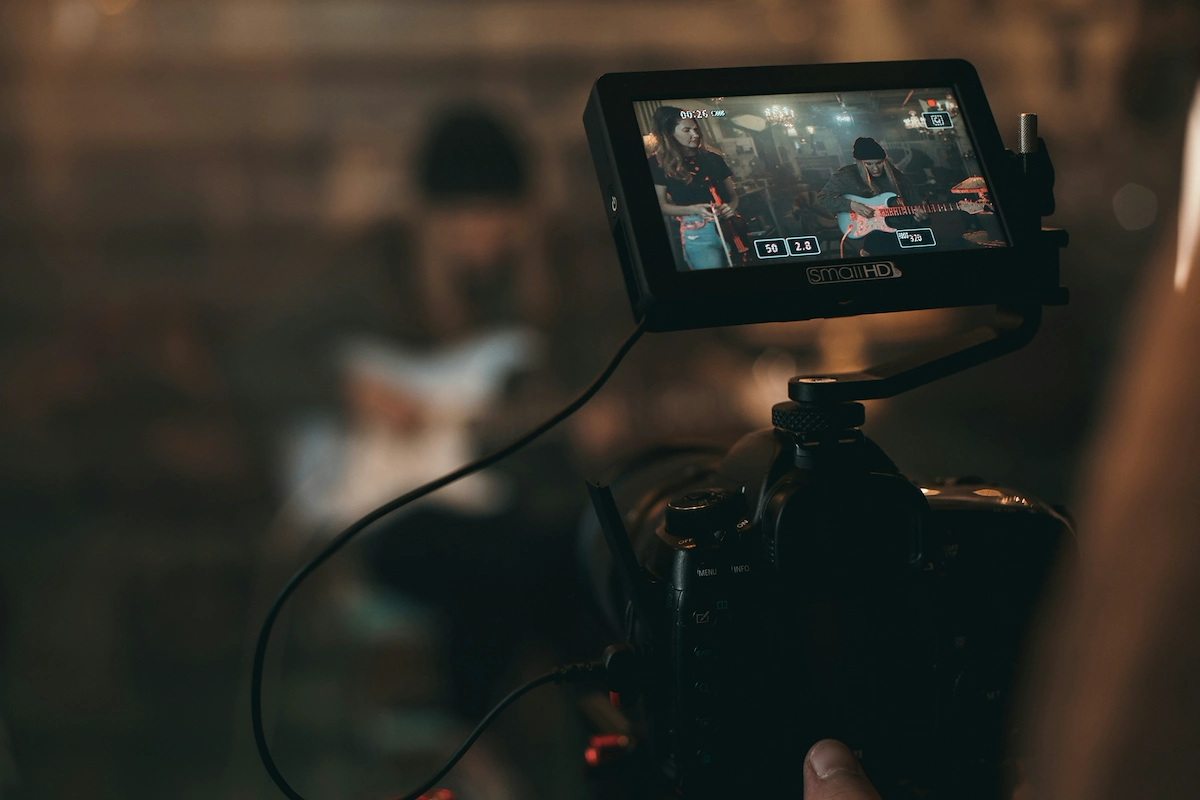Launching a videography business is an exciting venture that blends your passion for visual storytelling with sharp business acumen. The market is a multi-billion dollar industry, with consistent demand for quality video from corporate clients, event planners, and digital marketers.
This guide will take you through the practical steps to validate your idea, acquire the right equipment, secure funding, and obtain necessary licenses to help you launch a successful videography business in the U.S.
Step 1: Plan your business and validate your idea
Define your niche and research the market
First, decide on a specific niche. You could focus on weddings, corporate videos, or real estate tours. A narrow focus helps you target clients effectively. Check platforms like Thumbtack and Upwork to gauge demand and see what rates similar services command in your area.
Next, analyze your local competition. Use Google Maps and Instagram to find at least three other videographers. Review their portfolios, service packages, and client testimonials. This research will show you where you can offer something different, whether on price, style, or service quality.
Estimate startup costs
Your initial investment will range from $7,000 to $20,000. A frequent mistake is to purchase too much specialized gear at the start. You might want to rent items like high-end cinema cameras or drones for your first few jobs until you confirm the demand.
With that in mind, here is a typical breakdown of expenses to expect:
- Core Camera & Lenses: $2,500 - $7,000
- Audio & Lighting: $1,000 - $2,700
- Computer & Editing Software: $2,000 - $5,000
- Business Formation & Insurance: $500 - $1,500
Here are 4 immediate steps to take:
- Identify one primary service niche, like corporate testimonials or wedding films.
- Interview five potential clients in your area to understand their needs and budgets.
- Analyze the portfolios and pricing of three direct competitors.
- Draft a startup budget based on a realistic equipment list.
Step 2: Set up your legal structure and get licensed
You might want to form a Limited Liability Company (LLC). This structure separates your personal assets from business debts. Many new videographers make the mistake of operating as a sole proprietor, which offers no such protection. An LLC costs between $50 and $500 to file with your state.
Once your LLC is approved, get an Employer Identification Number (EIN) from the IRS. It is free and you can apply online. You will need this number to open a business bank account and file taxes.
Secure your licenses and permits
Next, check with your city clerk for a general business license, which typically costs $50 to $100 annually. Depending on your state, you may also need a seller's permit if you sell physical media like USB drives.
Filming permits are a big part of this business. Public parks, city streets, and national parks all require them. Costs can range from $50 to over $400 per day. Always check with the local film office or parks department weeks in advance.
If you plan to offer drone footage, you must get a Part 107 license from the FAA. This involves passing a knowledge test, which costs around $175. Flying commercially without this license can lead to heavy fines.
Here are 4 immediate steps to take:
- File for an LLC with your state's Secretary of State.
- Apply for a free Employer Identification Number (EIN) on the IRS website.
- Research your city’s business license and specific filming permit rules.
- Schedule your FAA Part 107 exam if you plan to use a drone.
Step 3: Insure your business and manage risk
Get the right coverage
General liability insurance is your baseline. It covers third-party injuries or property damage. A $1 million policy is standard and costs about $400 to $700 annually. Many venues will require you to show proof of this coverage before you can film on their property.
Next, you need professional liability, also known as errors and omissions. This protects you if a client claims your work is inadequate, for example, if you lose their wedding footage. Expect to pay $500 to $1,000 per year for a $1 million policy.
Your gear needs its own policy. Inland marine insurance, often called equipment insurance, covers your cameras and computers against theft or damage. A policy can cost between $250 and $600 annually, depending on the value of your equipment.
A frequent mistake is to assume your personal auto insurance covers business travel. It usually does not. If you use your car for shoots, you need a commercial auto policy. Also, if you hire help, you will need workers' compensation insurance, as required by your state.
When you look for a provider, consider specialists like Hiscox, Full Frame Insurance, or The Hartford. They understand the unique risks of videography, from drone accidents to data loss, and can offer policies tailored to your work.
Here are 4 immediate steps to take:
- Create a detailed inventory of your gear to determine your equipment coverage needs.
- Request quotes for general and professional liability from two specialized insurers.
- Review your personal auto policy to confirm its business use limitations.
- Ask potential venues about their minimum insurance requirements.
Step 4: Set up your workspace and buy equipment
Most videographers start from a home office, which keeps overhead low. Check your local city or county website for home-based business zoning rules. Some residential areas have restrictions on client traffic or signage, so it is good to know the regulations upfront.
If you need a dedicated studio, look for commercial spaces around 300-500 square feet. When you negotiate a lease, you might ask for a shorter 1-2 year term. This gives you flexibility as your business grows and avoids a long-term commitment early on.
Purchase your core equipment
Many new owners make the mistake of buying all their gear brand new. You can save 30-40% by purchasing used equipment from reputable sites like MPB or KEH Camera. This allows you to afford higher-quality items without inflating your startup budget.
Here is a sample list of what you might need to get started:
- Full-frame mirrorless camera: $2,000 - $3,500 (e.g., Sony A7 IV)
- Versatile zoom lens: $1,500 - $2,200 (e.g., 24-70mm f/2.8)
- Professional shotgun microphone: $500 - $700 (e.g., Rode NTG series)
- LED light kit: $350 - $800 (e.g., Aputure Amaran)
Retailers like B&H Photo Video and Adorama are industry standards for both new and used gear. Since they are retailers, you will not face minimum order quantities. You can buy a single lens or a full camera package.
Here are 4 immediate steps to take:
- Review your local zoning ordinances for home-based business rules.
- Browse used camera bodies and lenses on MPB to compare prices against new.
- Price out a starter kit with a camera, lens, mic, and light from B&H Photo Video.
- If you are considering a studio, search commercial listings for spaces under 500 sq. ft.
Step 5: Set up payment processing and financial systems
A standard practice is to require a 50% non-refundable deposit to secure a booking. The remaining 50% is typically due upon final delivery of the video files. Always outline these terms in your client contract. Many new videographers forget this and end up chasing payments.
Choose your payment processor
You will need a way to accept credit cards and digital payments. Many processors charge around 3% per transaction plus monthly fees. For videographers who need to accept payments on-site or on-the-go, JIM offers a streamlined solution. With JIM, you can accept debit, credit and digital wallets directly through your smartphone - just tap and done.
At just 1.99% per transaction with no hidden costs or extra hardware needed, it's particularly useful for collecting final payments on location after a shoot. Getting started is straightforward:
- Get Started: Download the JIM app for iOS.
- Make a Sale: Type the sales amount, hit sell, and ask your customer to tap their card or device on your phone.
- Access Funds: Your money is available right on your JIM card as soon as the sale is done - no waiting for bank transfers.
Here are 4 immediate steps to take:
- Draft a standard client contract that specifies a 50% deposit.
- Open a dedicated business bank account to keep finances separate.
- Compare payment processor fees to find a low-cost option.
- Download the JIM app to explore its features for on-location payments.
Step 6: Fund your business and manage cash flow
For initial funding, you might want to look into an SBA Microloan. These loans go up to $50,000, with interest rates typically between 8-13%. You will need a strong business plan and a good credit score to qualify.
Another option is equipment financing. This lets you purchase gear with the equipment itself as collateral. This approach preserves your cash for other operational costs. Also, search for grants from your local arts council, as they sometimes offer funds for creative entrepreneurs.
Estimate your working capital
You will need about $6,000 to $9,000 in working capital to cover your first six months. Many new owners budget for gear but forget about recurring costs like software, insurance, and marketing. This capital ensures you can operate before client payments become consistent.
Here are 4 immediate steps to take:
- Review the SBA Microloan program requirements on their website.
- Calculate your estimated operating costs for the first six months.
- Search for "arts council grants" in your city or state.
- Request a quote for equipment financing from a lender.
Step 7: Hire your team and set up operations
Define key roles and pay
You will likely start as a solo operator, but your first hire will probably be a freelance second shooter for larger events like weddings. Their job is to capture alternate angles and B-roll. A typical day rate is $250 to $400, or $25 to $50 per hour.
As you get busier, a freelance video editor can take over post-production. They often charge $30 to $75 per hour. A mistake many new owners make is hiring help without a contract. Always use an independent contractor agreement that defines the scope, payment, and deadlines.
Streamline your client workflow
To manage projects, you might want to use a studio management platform like HoneyBook or Studio Ninja. These systems handle inquiries, contracts, and invoices, which keeps you organized and looking professional. They help you avoid administrative headaches as your client list grows.
For the review process, consider a service like Frame.io. It lets clients leave time-stamped notes directly on your video drafts. This prevents confusing email chains and clarifies feedback, which saves you from endless revision cycles. Aim to keep labor costs under 40% of a project's total fee.
Here are 4 immediate steps to take:
- Draft a standard independent contractor agreement for freelance hires.
- Define the day rate you will offer a second shooter for a typical wedding.
- Sign up for a free trial of a studio management platform like HoneyBook.
- Create a standard operating procedure for your client video review process.
Step 8: Market your business and get clients
Build your portfolio and online presence
Your portfolio is your most powerful sales tool. You should create a 90-second demo reel that showcases your best shots. Many new videographers make the mistake of showing everything. Instead, be selective and highlight your unique style to attract the right clients.
Once you have a strong reel, feature it on a simple, professional website. Platforms like Squarespace or Wix offer clean templates. Also, create a business profile on Instagram and Vimeo. Post a mix of finished projects, behind-the-scenes clips, and client testimonials to build credibility.
Reach out to clients directly
Identify who hires videographers in your niche. For weddings, connect with 10-15 local wedding planners. For corporate work, find marketing managers on LinkedIn. A personalized email that references their work can get a much better response than a generic message.
You can also list your services on platforms like The Knot or WeddingWire for event work. For corporate gigs, Upwork can provide initial projects. A good goal is to convert 2-3% of your website visitors into inquiries. Track your marketing spend to keep your client acquisition cost low.
Here are 4 immediate steps to take:
- Create a 90-second demo reel with your best footage.
- Set up a professional Instagram profile and post at least five portfolio clips.
- Identify ten local wedding planners or marketing agencies to contact.
- Draft a personalized cold email template to introduce your services.
Step 9: Set your pricing and create packages
Your pricing strategy directly impacts your profitability. A common approach is project-based pricing, where you charge a flat fee for a defined scope, like a wedding film. Aim for a 50-60% profit margin on each project after you account for all costs.
Develop your service packages
Create three tiered packages. For example, a basic wedding package at $3,000 could offer 8 hours of coverage and a 5-minute highlight reel. A premium $5,500 package might add a second shooter, drone footage, and a 15-minute feature film.
Many new videographers underprice their work to land their first jobs. This can make it difficult to raise rates later. Instead, calculate your costs, add your desired profit, and then compare that figure to what local competitors charge for similar work.
For smaller or custom jobs, you might want to set an hourly rate. A typical post-production rate is $50 to $150 per hour, depending on your experience and the complexity of the edit. Always get a 50% deposit upfront to secure the booking.
Here are 4 immediate steps to take:
- Calculate your total costs for a sample project, including labor and software.
- Research the package pricing of three direct competitors in your niche.
- Draft three distinct service packages with clear deliverables and prices.
- Establish an hourly rate for editing and custom video work.
Step 10: Maintain quality and scale your operations
Establish your quality standards
Your reputation depends on consistency. Create a quality control checklist for every final export. It should cover technical minimums like 4K resolution and clean audio, plus creative checks for color grading and story pacing. This ensures every client receives your best work.
To measure your service quality, track the number of revision requests per project. Your goal should be fewer than two rounds. You can also send a simple follow-up survey to calculate a Net Promoter Score (NPS) and ask for testimonials.
Know when to grow
Growth should be data-driven. If you are booked more than 80% of the time for three consecutive months, it is a signal to raise your rates by 10-15%. When post-production consistently takes over 15 hours of your week, it is time to hire a freelance editor.
A frequent mistake is to hire help without a repeatable process, which creates chaos. First, document your entire client workflow in a studio management platform like HoneyBook. This playbook ensures new team members can deliver work that meets your standards from day one.
Here are 4 immediate steps to take:
- Create a technical quality checklist for all final video exports.
- Calculate your client referral rate from the last six months.
- Set a personal time-tracking rule for when to hire a freelance editor.
- Document your client workflow in a studio management system.
Conclusion
You now have a clear path to launch your videography business. Remember, your unique style is your biggest asset, but consistent client communication and solid contracts are what build a lasting reputation. Stay creative, stay professional, and you will build a business that lasts.
And when it comes to getting paid, keep it simple. JIM lets you accept card payments directly on your smartphone for a flat 1.99% fee, with no extra hardware. You get your funds instantly. Download JIM to be ready for your first client.















